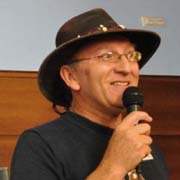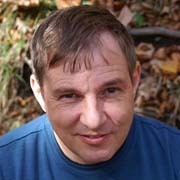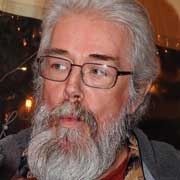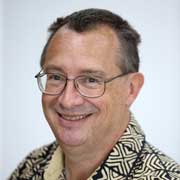Programme 6-7-8 September 2019
-
Day 1
-
Plant sales
-
Opening and lecture
Joël Lodé
France

The new Taxonomy of the Cactaceae and its implications (en)
Joël Lodé is a naturalist adventurer originally from Nantes, France, the home of Jules Vernes. Inspired by Jules Verne’s adventures, he has travelled extensively around the world on many adventures, including an around-the-world bicycle trip that started in 1975. This led to the first encounter with his first cactus in California, an unpleasant encounter due to a flat tyre! He has presented lectures on cacti and other succulents in many countries. He also publishes the quarterly journal “International Cactus Adventures” and manages the website Cactus-Adventures.com. He has written several books including “Succulent Plants of the Canary Islands”, “Succulent Plants of Socotra” and more recently, “Taxonomy of the Cactaceae” in two volumes.
A definitely modern, pedagogical and above all very personal way of presenting the new taxonomy of the Cactaceae and its implications: this is what this very different lecture proposes in its concept and presentation, unexpected even for a subject that is nevertheless serious: the classification of cacti, the new DNA data, but also the secrets of a prickly world that holds many surprises.
-
Réunion des francophones
-
Cafetaria
Social gathering
-
Day 2
-
Plant sales
-
Lecture
Roland Reith
Germany

Ein Leben mit Kakteen (de)
A life with cacti
Collecting something has been in our blood since earliest mankind. Whereas collecting food was originally a necessity to survive, today in the industrial countries collecting has a totally different meaning. Many of my cactus friends have been collecting and dealing with cacti and other succulent plants for several decades, some of them even for half a century or more. Often they still know how their hobby started. Sometimes it was a deliberate choice, sometimes sheer coincidence.
In my audio-visual presentation I show with pictures and films from my collection and from my travels to North and South America and to South Africa how the passion for cacti and succulents can look like, how it develops and in what we are interested in these plants. Especially visiting the plants in the deserts and semi-deserts of this earth shows us the adaptability that the plants have developed and the strategies with which they can defy the most adverse conditions. We will visit the US deserts, pictures from the Chilean Atacama desert but also from the highlands of Argentina. Bolivia and Peru will show us fascinating landscapes and habitats. Also the systematics and the taxonomy will be discussed. We will see examples of extreme spination, of special adaptations to the habitats and of course of beautiful flowers. But we also must deal with the changes in the homelands by human interference and not at least by the climate change.
Our collecting has not least something to do with commitment. We took a decision a long time ago by selecting these interesting plants. Our actions are largely determined by it. We neither need nor want to follow every new trend anymore. We no longer have to weigh up whether our decision was the right one and look for always new, supposedly better possibilities. We know that we have taken the right decision and have a deepened feeling of satisfaction in our passion for cacti. We have the most beautiful hobby you could wish for.
-
Meeting International Euphorbia Society
Meeting Cactus Francophone
-
Lecture
Paul Klaassen
The Netherlands

Mist (nl)
Fog
Born in the Netherlands, Paul won his first cactus show at school in 1959. His Opa (Grandad) gave him his first subscription to Succulenta, the Dutch C&S Society, as a birthday present in 1963. He moved with his family from the Netherlands to Denmark and later to England where he still lives. In 1997 Paul made his first trip to Cactus Country, travelling through New Mexico, Arizona, Utah, and Colorado. This first trip fired up a passion to see cacti in their habitat in preference to pots at home. Since then Paul has explored for cacti and other succulent plants in South Africa and Namibia, South America (Argentina, Bolivia, Brazil, Chile, and Peru) and North America (USA, Mexico and Cuba). One feature of Paul’s trips has been the publication of his Trip Diaries on the internet: pkcactus.wordpress.com.
During my trips to various ‘cactus and succulent plant’ countries, I always take GPS readings to record where the plants grow. After trips to the Chilean Atacama Desert and the Mexican States of Baja California, I noticed that the plants often grew in dense fog and that the latitudes were very similar, except that in Chile they were south of the Equator while those in Mexico grew in the northern hemisphere. The Tropics are said to occur at 23 o 26’, but in reality, this varies between 22 and 24.5o. After searches on the Internet, I learned that the most arid parts of the world occur around the Tropics of Capricorn and Cancer, ideal for succulent plants including cacti. Where a cold Gulfstream passes along warm land, this often results in mist or fog. I, therefore, photographed plants living in fog deserts. After more searches on the Internet, I learned that there is another important fog desert along the Namibian coast, so I had to visit there as well.
My presentation shows how fog allows plants to grow here and which plants we found.
-
Meeting Tephrocactus Study Group
-
Lecture
Due to unforeseen circumstances, Marlon Machado is unable to give his planned lecture. With Professor Ralph Martin we have a worthy replacement.
UK

Rebutias Then and Now (en)
Ralph Martin is an Emeritus Professor of Computer Science at Cardiff University. He has grown cacti and succulents as a hobby since he was a schoolboy. He is a member of the BCSS, DKG, CSSA and other specialist societies. He regularly gives talks to BCSS branches about cacti and succulents, how to grow them, and his visits to habitat. Cactus enthusiasts will know Ralph from “Ralphs Martin’s Field Number Database”. He regularly has plants for exchange with fellow enthusiasts – look for his web site!
Ralph Martin will consider the genus Rebutia, and the plants that have been included in it, both in the past, and now: Rebutia, Aylostera, and Mediolobivia (and more). DNA evidence is briefly summarized, which shows that Aylostera and Mediolobiva are closely related to each other, but are quite distant from the "true" Rebutias. He will then finish with a few portraits of various true Rebutias and Aylosteras / Mediolobivias, and some observations.
-
Meeting International Asclepiad Society
-
Cafetaria
Social gathering
-
Day 3
-
Plant sales
-
Lecture and Closing
Diane Ortolani
Monaco

Le déménagement du Centre Botanique de Monaco (fr)
The relocation of the Botanical Centre of Monaco
I have been interested in the animal and plant world since I was a child. This interest guided my studies and allowed me to obtain a master's degree in earth sciences and life. The protection and conservation of species is particularly important to me. In 2009, I joined the Botanic Garden team and was able to improve my knowledge of succulent plants and discover all that was being done in terms of species conservation and protection. The work, varied and motivating, allows me to evolve within a field that fascinates me.
As part of a global project to redevelop the western entrance to the Principality of Monaco, the former greenhouses of the Botanic Garden had to be moved. The first digging was carried out in September 2015, the inauguration of the Botanic Centre took place on 31 October 2017. We moved a total of 10,500 plants, 10,000 pot plants and 500 plants in open ground, representing 80% of the work. This move required 3 years of work, including one year of design. This Botanic Centre has been completely redesigned to allow for visitors.